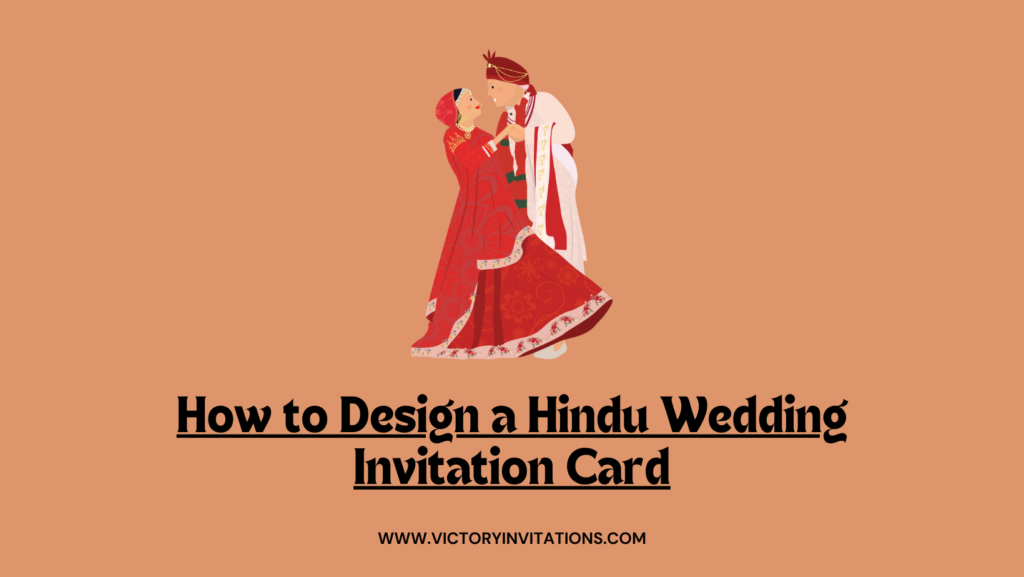Designing a Hindu wedding invitation card is a beautiful process, as these cards often reflect cultural traditions, religious symbols, and vibrant aesthetics. Here’s a guide on how to design one:
1. Color Scheme
- Traditional Colors: Red, gold, maroon, and saffron are common as they symbolize prosperity, purity, and joy. Green is also popular as it signifies life and happiness.
- Modern Trends: While traditional colors are significant, modern designs may include pastel shades like blush pink, mint green, or soft lavender, adding a contemporary touch.
2. Symbols and Motifs
- Ganesha: Lord Ganesha, the remover of obstacles, is often depicted at the top of Hindu wedding invitations for blessings.
- Om or Swastika: These are auspicious symbols frequently used to invoke divine blessings.
- Lotus Flowers: Representing beauty, spirituality, and purity, lotus designs are often incorporated.
- Peacocks: Symbolizing elegance and grace, peacock motifs are popular in wedding invites.
- Paisley Motifs: Traditional Indian design elements like paisley patterns can enhance the elegance of the card.
3. Layout
- Main Invite: Begin with a warm introduction, often invoking blessings from deities.
- Names of Bride and Groom: Make sure the names of the couple are prominently displayed.
- Date, Time, and Venue: Clearly state the wedding date and time according to the Hindu calendar if needed. The venue details should be precise and easy to find.
- Special Ceremonies: Hindu weddings often have multiple ceremonies (Mehendi, Sangeet, Pheras). You can include a timeline or individual inserts for each.
- RSVP and Contact Details: Include an RSVP section with contact details or a digital link.
4. Typography
- Fonts: Choose traditional fonts like Sanskrit-style or decorative fonts for the couple’s names. The body text should remain clear and readable, balancing elegance with functionality.
- Languages: If the invite is in Hindi or any regional language (like Gujarati, Tamil, or Marathi), ensure you choose fonts that are legible yet beautiful. Sometimes, bilingual invitations (English + native language) are a practical choice.
5. Paper and Texture
- Paper Quality: Use high-quality textured paper (e.g., handmade paper, silk matte finish) for a premium feel.
- Foiling: Gold or silver foiling adds a regal touch, especially for names, borders, or symbols.
- Embossing: Embossing the couple’s names or symbols like Lord Ganesha can make the card feel rich and luxurious.
6. Interactive or Digital Elements
- QR Codes: For digital RSVPs, directions to the venue, or links to wedding websites, adding a QR code can modernize the invitation.
- Video Invitations: Hindu wedding invitations can be delivered digitally with an embedded video of the couple or animated versions of traditional elements.
7. Personalization
- Family Crests: Incorporating family symbols or a personalized wedding logo adds a unique touch.
- Photos of the Couple: Some designs may include small, elegant photos of the couple, either in the form of an illustration or a real image.
8. Borders and Embellishments
- Ornate Borders: Borders with intricate designs, such as Mughal art or mandala patterns, enhance the card’s beauty.
- Lace and Ribbons: For physical cards, adding decorative ribbons, gems, or lace can make the invitation stand out.
9. Envelope Design
- Match the Card: The envelope should complement the card in color and design.
- Wax Seals: A wax seal with the couple’s initials or a symbol like Om or Ganesha adds a personal touch.
10. Invitation Wording
- Traditional Blessings: Start with a short prayer or blessing invoking divine blessings.
- Warm Tone: The language should reflect joy and warmth, inviting guests to be part of the celebration.
- Formal vs. Casual: Depending on the family’s preference, the tone can be either formal or casual.
11. Cultural Details
Hindu weddings are filled with rituals and religious significance. Including a brief description of important ceremonies in the invitation helps guests understand what to expect:
- Haldi Ceremony: A pre-wedding ritual where turmeric paste is applied to the bride and groom for blessings and purification.
- Mehendi Ceremony: A fun, vibrant event where henna is applied to the bride’s hands and feet.
- Sangeet: A musical evening of dance and celebration held before the wedding.
- Pheras: The main wedding ritual, where the bride and groom take seven sacred vows around the holy fire.
These descriptions can be included as inserts or written briefly within the invitation.
12. Types of Invitation Cards
Depending on your preferences, you can choose different formats:
- Single-Sheet Card: Simple and concise, with all details on one card.
- Layered Cards: Cards with multiple inserts, each for a different event (e.g., wedding, reception, Mehendi).
- Scroll Invitations: For a royal, traditional feel, scroll invitations (or “Farman”) are popular, with ornate cases or ribbon ties.
- Box Invitations: Deluxe cards that come in a box, often with sweets, dry fruits, or small gifts inside.
13. Digital Invitations
- With the growing trend toward eco-friendly options, many couples are opting for digital Hindu wedding invitations. These are typically shared via WhatsApp, email, or social media platforms.
- The design for digital invites should be optimized for screens, with crisp colors and easily readable fonts.
- Interactive Elements: Use animations of symbols like a diya (lamp), Ganesha, or peacocks for a dynamic touch.
- Video Invitation: You can also create a beautiful video with music and animations, highlighting the key moments of your wedding journey and the ceremonies to follow.
Example Invitation Wording
With the blessings of Lord Ganesha and our parents, we cordially invite you to celebrate the union of our beloved children, Ananya and Rohan, as they begin their journey of love and togetherness.



